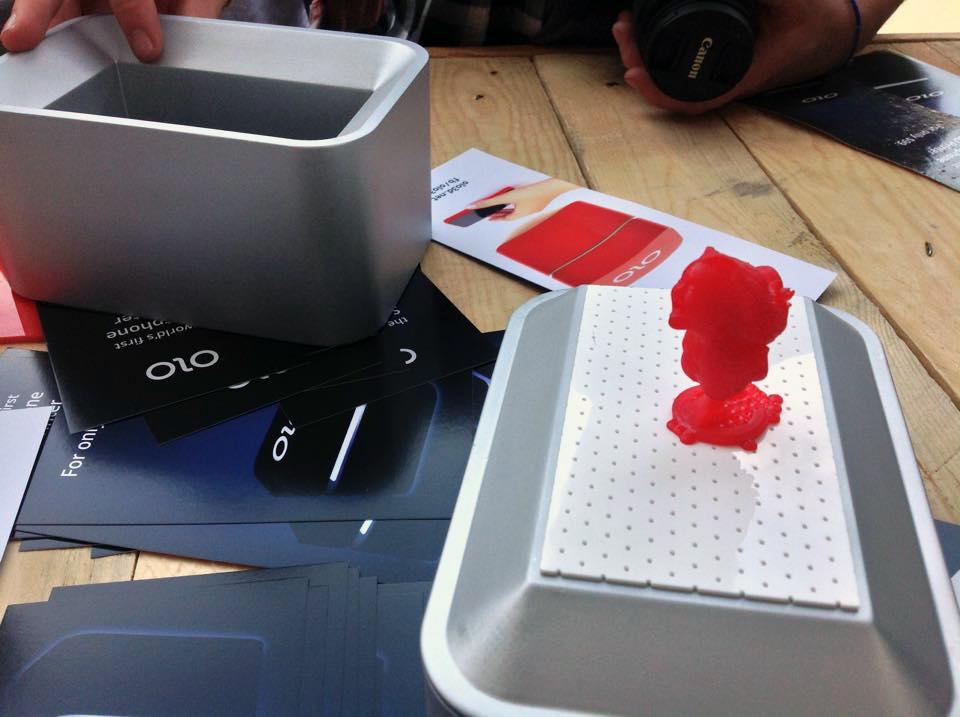Results 1 to 9 of 9
-
10-05-2015, 08:09 PM #1
OLO 3D Printer - Powered By a Smartphone
Italian developer and ‘digital family’ SOLIDO3D will soon be releasing the OLO smartphone 3D printer on Kickstarter. Compatible with Windows phones, Android, and iOS, the compact little game-changing piece of technology is expected to be app driven in an open source platform, super user-friendly, and should really integrate 3D printing even further with social media. Read more details in the full story: http://3dprint.com/99081/olo-smartphone-3d-printer/

-
10-06-2015, 05:39 AM #2And that's a good thing ?and should really integrate 3D printing even further with social media.
So the scant details available make it look like a resin based machine - and for that price, most likely something very similiar to the peachy setup.
It's another one in the constantly growing group of machines that print really small. I noticed flashforge have now released what looks very much like a micro3d clone.
Resin machines still remain a bit messy - but can be made with minimal moving parts.
The smart phone tie in is simply a gimmick, and not a well thought out one either - like those dedicated photo printers they brought out a few years back, that plugged straight into your camera or phone.
They didn't really catch on and I don't think a printer that's going to hog your phone for a few hours while it prints will go down all that well either.
It'll most likely hook up on wifi. So while your phone can multitask and run the printer while you facebook - leave your house and the printer stops, go out of wifi range and the printer stops, lose signal - the printer stops.
And cheap sla machines aren't exactly known for their speed of printing.
When you consider that a 7 inch quad core android tablet can be had for £30 and could be incorporated into the case, making the printer marginally more expensive but totally independant of your precious phone.
It's nothing more than a gimmick.
-
10-06-2015, 06:19 AM #3Student

- Join Date
- Nov 2014
- Posts
- 21
I agree on the social media aspect. IMHO it's unnecessary.
Using a phone or tablet as interface is ok, as long as you have some brains in the printer. I use a raspberry to control my B9Printer. It does neither have nor need any control elements (screen/keys/mouse) attached. It is basically a webserver, that gets the data to print and communicates via a webpage with the outside world. So you start, stop, control prints from your computer, tablet, phone or iWatch (needs a special software), but they are not needed for the print procedure itself. So if you get out of range the print does not stop.
Put such a Raspberry like computer and a Led projector in the lid use resin that hardens under visible light and there you go. Putting the projector in the lid saves the hassle of a dedicated release mechanism/procedure.
Could work.
I'm afraid it will give 3D printing a bad name. Small buildspace, medicore print quality, toylike.
They might go like "3D printing is totally overrated, I used my OLO only 4 times. All you can make is small brittle things. Takes hours and than I spilled that green stuff on my trousers, and that green doesn't agree at all with the trousers pattern.."
-
10-06-2015, 06:59 AM #4
I was looking to see what I could find on this. At first I thought the phone would be controlling the printer. But it appears they are claiming that they are using the phone as a DLP. This seems unlikely. Phone screens do not project an image. And the intensity of the light would not be enough to do anything. Also in one article it claimed to use a polarizing filter to "bend the light going to the side.????? That is not what a polarizer does. It would just reduce the amount of light. Plus they never show it working. Looks like a scam to me.
-
10-06-2015, 07:06 AM #5Engineer-in-Training

- Join Date
- Jul 2014
- Location
- Ontario, Canada
- Posts
- 257
Was anyone at MakerFaire able to see a functioning prototype?
I hate to sound so negative most of the time, but all I see here is a box with some fancy branding and marketing behind it. No details about the specs, or technology, nothing showing their development...frankly, show me something that works instead of all this marketing hype...
-
10-06-2015, 07:09 AM #6Engineer-in-Training

- Join Date
- Jul 2014
- Location
- Ontario, Canada
- Posts
- 257
I believe the iBox Nano uses a standard LCD with high contrast images to project each layer, so I don't think it's outside the realm of possibilities, but it does raise the question, if it does indeed work this way, how does a screen protector or dirty/smudged screens affect the print quality, and also, wouldn't the physical size of the phone's display dictate its build volume?
-
10-06-2015, 09:12 AM #7
I just took a quick look at the Nano. My problem is not in using an LCD. It is the type of LCD. The screen in a smart phone is not intended to be a projector. At the very least it would need focusing. The intensity is too low. And I doubt the there is much in the way of UV. The Nano probably uses a UV source shinning though the LCD. A smart phone probably uses white LEDs.
-
10-06-2015, 09:59 AM #8Staff Engineer

- Join Date
- Dec 2013
- Location
- Georgia
- Posts
- 934
The article missed one very important detail that answers a lot of questions.
So it has to use a patented proprietary resin. On the one hand, these guys are business geniuses. On the other, they might price it so high that they fail in the face of certain victory.Along with the OLO, Solido3D will be launching their patented resin, optimized for the OLO’s smartphone display light-source.
-
10-09-2015, 09:27 AM #9Student

- Join Date
- Oct 2015
- Posts
- 1
You may be interested in Liquid Crystal, a new printer using a 10" LCD screen, launched at TCT in the UK last week by Photocentric, a photopolymer manufacturer - www.photocentricgroup.com The cost is just $799. It will start shipping 1st week December..






 Reply With Quote
Reply With Quote






Extruder not feeding during print,...
Yesterday, 01:59 AM in Tips, Tricks and Tech Help